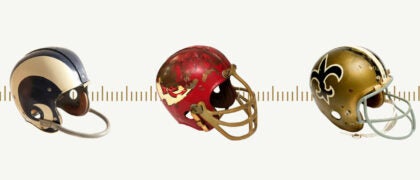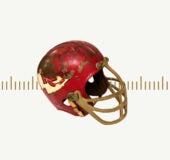Chapter 1
League Talk
Professional football as we know it began in the fall of 1892 when one William “Pudge” Heffelfinger, an All-American tackle from Yale, accepted a $500 cash payment to play for the Allegheny Athletic Association. The AAA played out of what today is the North Shore of Pittsburgh.
If $500 sounds like a cheap deal, consider this: $500 back then had the buying power of roughly $13,000 today.
And this: Heffelfinger’s payment from the AAA was for a single game, against their crosstown rival, the hated Pittsburgh Athletic Club (PAC). The AAA won the game 4–0 (touchdowns were worth four points from 1892 to 1898, five points from 1898 to 1911, and six points starting in 1912) and Heffelfinger earned his pay scoring the game’s only touchdown on a 35-yard fumble recovery.
Evidence of Heffelfinger’s role in the creation of professional football can be found today in the Pro Football Hall of Fame, preserved on a slightly yellowed page of the AAA’s expense accounting ledger for November 12, 1892.
Ironically, what would have been considered damning evidence of unethical professionalism back then is now proudly displayed at the Hall of Fame as pro football’s “birth certificate.”
While the indelible-ink entry is proof positive of Heffelfinger’s pay, it’s unlikely that the recompense was truly the first time the purity of the sport’s amateur code had been violated. In fact, under-the-table payments to “ringers” were becoming more and more commonplace. It’s just that in Heffelfinger’s case, the AAA put it in writing.
Eventually the practice of paying players became so routine that some amateur clubs, including the AAA, simply decided to be open about it.
While the result was better football, the high cost of bidding for the services of the best players created an unanticipated financial strain on some of the athletic clubs, so much so that one by one they began to drop football altogether.
Also, “ringers” were never fully embraced by team loyalists. One week player X was a welcomed member of the “home team” and the next he was an unwelcomed opponent. As a result, fan acceptance of the pro version of football, particularly in the “amateur athletic clubs” of Pennsylvania and New York, began to wilt.
However, in nearby Ohio, the opposite seemed to be happening. Amateur competition in cities like Akron, Canton, Dayton, Massillon, Shelby, and Youngstown became so competitive that teams began to openly recruit play-for-pay athletes.
In 1903, the Massillon Tigers became the first Ohio team to blatantly lure players with cash. Others followed, including Massillon’s fiercest rival and Stark County neighbor, Canton. Prior to the start of the 1905 season, the Canton Athletic Club (CAC) announced that their football team would be a “professional organization,” complete with a “professional coach.” The mission of the rechristened Canton Bulldogs was simple: beat Massillon.
Suddenly, Ohio was the hotbed of professional football. A small group of pro teams, mostly from the northeastern part of the state, became known as the “Ohio League.”
The Ohio League was an unstable entity whose makeup changed from year to year as teams folded and new ones emerged. The informal “league” usually included three to five teams and, depending on their fortunes, one or two from other Ohio cities like Columbus, Cincinnati, or Dayton. An imaginary title was claimed by the team faring the best against the other entries.
Although semipro or pro teams could be found in many small midwestern cities and towns by the early 1900s, the Ohio League teams were clearly the best. They recruited the best, paid the most, and drew the largest crowds.
But make no mistake—the game was far from being a serious challenge to college football, major-league baseball, boxing, or even horse racing. Critics claimed it lacked organization, stability, credibility, and integrity, and to a large extent, they were right.
Adding fuel to that fire was a controversy in which a Bulldogs player, Charles “Blondy” Wallace, allegedly attempted to fix an important late-season game in 1906, between Canton and Massillon. Although no real evidence to support the charges was presented, the well-publicized allegations helped to validate critics’ claims that pro teams were nothing more than disorganized bunches of vagabond tramp athletes willing to play for the highest bidder.
The resulting lack of public confidence, compounded by the ever-increasing cost of securing well-known players, caused Canton to fold following the 1906 season. Though Massillon continued to operate, they did so as a second-tier team with a substantially smaller payroll. Gone after two seasons was Ohio’s first pro football rivalry. And without its two best-known teams, the other Ohio League teams suffered as well.
Then, in 1912, a twenty-one-year-old “sports enthusiast” named Jack Cusack offered his unpaid services as treasurer and secretary to a newly organized Canton Professionals football team. Within weeks the aggressive rookie promoter found himself in total control of the born-again football club.
Cusack set out to restore Canton to its earlier prominence. To that end, in 1915 he lured Olympic champion Jim Thorpe, the biggest name in sports, to Canton. Anxious to resurrect the rivalry between Canton and Massillon, Cusack rechristened his Canton team the “Bulldogs” and scheduled two games—home and away—with the newly reorganized Massillon Tigers.
In Thorpe, pro football had its first bona fide star and a major gate attraction. Some fans could hardly believe it when word leaked that Cusack was paying him $250 per game.
“Even the most loyal Cantonites thought Cusack had lost his mind and would soon lose his shirt,” wrote pro football historian Bob Carroll. But when 6,000 paying customers showed up for the first Canton-Massillon game and 8,000 for the second, the doubters were silenced. The Thorpe-led team went on to capture Ohio League championships in both 1916 and 1917.
While Thorpe’s presence certainly bolstered attendance and revenues for Canton, things weren’t as rosy for the other Ohio League teams. For them, except for games against Canton, attendance and revenues were down. A good part of the downturn, however, had nothing to do with the game.
On April 6, 1917, the United States officially entered World War I. Almost immediately teams felt its effect as players either enlisted or were drafted.
Compounding the problem, a deadly influenza pandemic swept the country in early 1918. To limit the spread of the outbreak, ordinances were passed restricting large gatherings, including sporting events. The manpower shortage and the fear of contagion caused most pro teams, including Canton and Massillon, to fold during the 1918 season.
While Cusack and other team managers proclaimed the interruption would be a one-year pause, no one could be certain pro football would survive.
Relief came with the war’s end in 1919 and the simultaneous decline of the pandemic. Anxious to pick up where they had left off, the four “Ohio League” teams ended their hiatus. But some serious challenges remained.
To begin with, during the wartime layoff, Cusack sold the Bulldogs to Ralph E. Hay, a twenty-seven-year-old Canton entrepreneur and owner of the Ralph E. Hay Motor Company.
Over in Massillon, while Tigers owners Jack Donahue and Jack Whalen proclaimed their readiness to once again field a team, their constant complaints about how much money they’d lost in 1917 cast a question mark over the new season.
To the north, Akron Indians owner Vernon “Mac” McGinnis indicated he was ready to give it another go. And even though Youngstown Patricians manager Mickey Stambaugh was drowning in red ink and angry about having his roster poached in 1917, he said he was willing to forgive and forget and start anew.
Despite these challenges, a sense of optimism seemed to take root among these strange bedfellows. Hay emerged as the group’s main cheerleader. Whether it was his naïveté as a rookie manager, previous entrepreneurial successes, having Thorpe under contract, or a combination of all three fortuitous circumstances, his passionate confidence was the dose of “recovery medicine” needed by a sport already on life support.
The same problems that faced the pro game ever since Heffelfinger’s big payday continued to plague the Ohio League in 1919: players jumping from one team to another for a few dollars more, high salary demands and bidding wars for “big name” players, and the signing of amateur collegians. Sound familiar? In many ways, they’re the same problems still facing the game today.
The Ohio League managers decided it was in their own best interest to at least discuss the issues. However, just getting together proved to be difficult. Three meetings in three different cities were needed to address the important matters before them.
Hay hosted the first meeting on July 14 in Canton. Massillon and Akron showed up. Youngstown didn’t. Manager Stambaugh was reportedly “on vacation.” Likely a hunting trip for additional investors.
Copyright © 2019 by Joe Horrigan. All rights reserved. No part of this excerpt may be reproduced or reprinted without permission in writing from the publisher.







